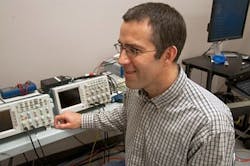Software helps map muscles in 3-D
An associate professor from Simon Fraser University (Burnaby, BC, Canada) has developed a new software tool that allows researchers to view the structure of moving muscles.
Fascinated with the mechanics of muscle movement in people and animals, James Wakeling’s method uses ultrasound imaging, 3-D motion-capture technology, and proprietary data-processing software to scan and capture 3-D maps of muscle structure in just 90 s.
Previous methods took 15 min to do the job -- far too long to ask people to hold a muscle contraction. “Now, we can get people to do muscle contractions and we can actually see how the internal structure of the muscle changes,” says Wakeling.
Wakeling’s goal is to improve the muscle models used in musculoskeletal simulation software that predicts how people move and the forces on their joints. Current packages are missing important information about muscle contraction, such as how the muscle shape changes, how it bulges, or how the internal muscle fibers become more curved -- all details that Wakeling’s technology can capture.
Wakeling hopes his research will ultimately lead to new software programs for predicting the outcome of orthopedic surgeries such as tendon transfers, which are used to treat conditions like cerebral palsy in children.
-- By Dave Wilson, Senior Editor, Vision Systems Design
